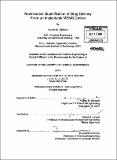Noninvasive quantification of drug delivery from an implantable MEMS device
Author(s)
Johnson, Audrey M., 1976-
DownloadFull printable version (11.83Mb)
Other Contributors
Massachusetts Institute of Technology. Dept. of Chemical Engineering.
Advisor
Robert S. Langer.
Terms of use
Metadata
Show full item recordAbstract
(cont.) sensors in vivo in real time and corroborated by scintillation of urine samples. The goal of monitoring drug delivery from an implant in vivo, in real time and without disturbing the tissue environment, was accomplished. The results described in this thesis suggest a number of future studies including feedback-controlled delivery of drugs and real-time monitoring and analysis of the effect of the immune response to foreign bodies on drug and analyte transport. The goal of this thesis was to develop a method for quantifying the rate of release of drugs from an implanted MEMS (micro electro mechanical systems) drug delivery device without disrupting the surrounding tissue. Most current methods for evaluating tissue response to implants and drug release are invasive and destructive. A method for measuring drug transport from implants in vivo, non-invasively and in real time, would have the potential to yield new information about the body's response to implants and the impact of the tissue response on drug and analyte transport. An impedance based sensor was designed to monitor the release of drug from the drug delivery MEMS device reservoirs. The sensor measures the change in conductivity of the contents of the reservoir as the drug dissolves, which is related to the drug release rate. A four element equivalent circuit was developed to describe the impedance spectrum of the reservoirs based on the physical components of the system. The solution resistance and double layer capacitance elements are functions of the amount of drug that has dissolved and were used to measure the drug release rate in real time. The sensors were tested by monitoring drug release in vitro in saline. Independent measurements of the radioactive tracer released from the well were in complete quantitative agreement with the release rates measured by the electrochemical sensors. A finite element transport model of the system also gave predicted release times in agreement with the sensor and radioactivity measurements of release times in stirred saline. MEMS devices with impedance sensors were implanted subcutaneously in rats and activated after 3-11 days post-implantation. Release of radiolabeled mannitol was monitored by the
Description
Thesis (Ph. D.)--Massachusetts Institute of Technology, Dept. of Chemical Engineering, February 2005. Includes bibliographical references.
Date issued
2005Department
Massachusetts Institute of Technology. Department of Chemical EngineeringPublisher
Massachusetts Institute of Technology
Keywords
Chemical Engineering.